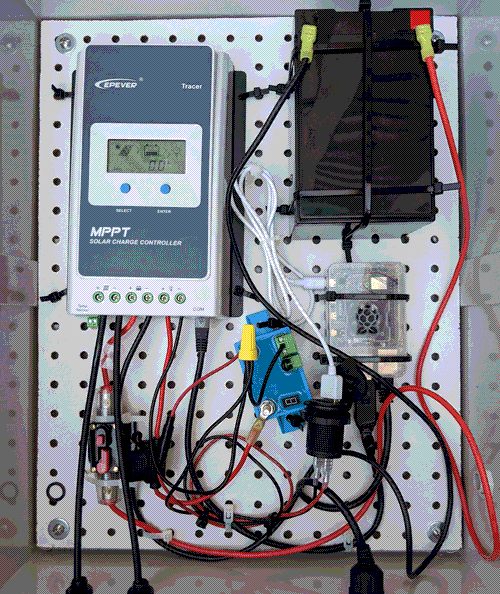Ushering in a New “Phase” of Solar Research
NYU Tandon engineers explore new approaches to materials synthesis, photovoltaic systems, and internet infrastructure to illuminate new potential for solar technologies.

Shifting the sun to increase solar cell efficiency
New lead-free film turns ultraviolet and blue light into near-infrared light, “shifting the sun” up to 95% with potential to break the 100% barrier
It’s an incontrovertible fact that silicon solar cells are not the best match for the solar spectrum since only certain wavelengths can be efficiently utilized with existing cells. Now, a team led by Professor of Chemical and Biomolecular Engineering Eray Aydil is tackling the nature of light itself – in effect, “shifting the sun” – by developing a film that can be used in solar cells to shift the light spectrum by up to 95%, turning ultraviolet and blue light (from the less efficient band of the spectrum) into near-infrared light (the more efficient source for solar cells).
The students working on the project, Minh Tran and Casey Bloomquist, took home top honors in the 2023 EnergyTech University Prize, and a startup, Heliotrope Photonics, has launched based on the technology.
Improving solar cell efficiency with new doping methods
Faster, more reliable doping method enhances electrical conductivity and enables stable, high-efficiency solar cells without lengthy post-treatments
Office Hours with André Taylor: Exploring the Ocean with Solar-Powered Drones
André Taylor – a Tandon professor of chemical and biomolecular engineering and director of DC-MUSE (Center for Decarbonizing Chemical Manufacturing Using Sustainable Electrification) – designs revolutionary photovoltaic systems and envisions new ways to manufacture them at scale, using sustainable, longer lasting, and more durable materials. He created a way to vastly increase the speed and efficiency of a key doping process for perovskite solar cells, with the added benefit of sequestering CO2, and he recently garnered a $300,000 award from the U.S. Department of Energy Solar Energy Technologies Office (DOE-SETO) for his efforts to fabricate next-generation cadmium-telluride (CdTe) solar cells using two-dimensional nanomaterials that are highly conductive and can be used as transparent contacts. The process will enable the use of low-cost processing techniques, like spray-coating and slot-die coating; their tunable surface properties could lead to higher-efficiency CdTe PV.
Unlocking underwater exploration with solar
Innovative materials combined with organic semiconductors can revolutionize autonomous systems to overcome power challenges holding back undersea data collection
Named one of the most inspiring Black scientists in America, Taylor also recently addressed a major obstacle in using autonomous underwater vehicles (AUVs) to explore the furthest reaches of the sea: the short power cycles of batteries and the absence of persistent onboard power sources. “A dive into underwater solar cells,” an article co-authored by Taylor and published in Nature Photonics, provides an in-depth look at possible solutions, which include combining solar power with oceanic thermal energy conversion, the use of gallium indium phosphide (GaInP) and cadmium telluride, and next-gen organic and perovskite cells.
Reimagining a climate-friendly, community-powered internet
A web platform hosted across a network of solar-powered servers set up in locations around the world aims to offer a solution to energy challenges related to transglobal trafficking of data through the web

The energy requirements of the Internet, the devices and systems using it and the servers that support it are responsible for greenhouse gas emissions equal to that of the global airline industry, and this carbon cost is growing rapidly with the expansion of blockchain-enabled transactions: The carbon footprint of a single Ethereum transaction is equivalent to nearly 329,000 credit card transactions.
Solar Protocol, a project developed by a team of researchers at the NYU Tandon School of Engineering, aims to offer a potential solution. Solar Protocol comprises a web platform hosted across a network of solar-powered servers set up in locations around the world. Besides being a workable system with implications for future servers, it constitutes a global installation that spotlights the politics of the web and different ways to track web traffic. In stark contrast to large-scale, high-volume web services that algorithmically direct network traffic to whichever server gives the quickest response time, usually the closest geographically, Solar Protocol, with about a dozen volunteer-run server nodes around the world, uses the sun’s interaction with Earth as the cornerstone. How the sun shapes daily behaviors, seasonal activities and the decision-making of almost all life forms becomes the “logic” used to automate decisions in the digital network. The team continues to explore the potential of the network with students through a long-term, large-scale experiential learning-driven Vertically Integrated Project team.

Learn more about Tandon’s sustainable engineering activities
In a world threatened by pollution and climate change, we believe that engineering holds the key to a greener, healthier future.
We are a group of engineers, researchers, educators, and innovators spanning multiple disciplines with a passion and commitment to sustainability.

